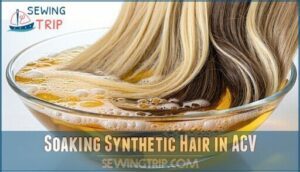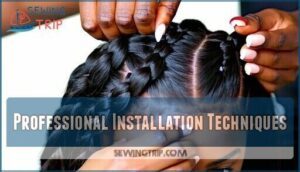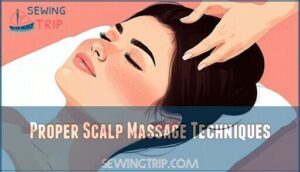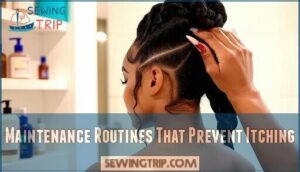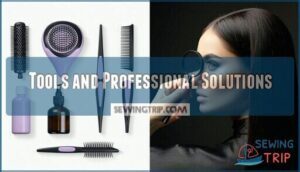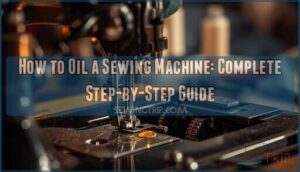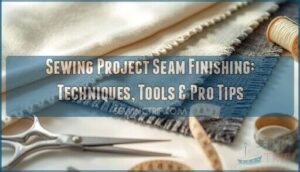This site is supported by our readers. We may earn a commission, at no cost to you, if you purchase through links.
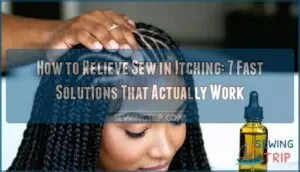
Massage your scalp gently to boost blood flow and distribute natural oils. Apply lightweight oils like jojoba or coconut directly to irritated spots. Use a scalp scratcher or rat-tail comb to reach tight areas without damaging your install.
Wash weekly with sulfate-free shampoo to prevent dryness. Sleep with a silk bonnet to retain moisture and reduce friction that worsens itching.
These quick fixes tackle the root causes—from tight braids restricting circulation to synthetic hair allergies.
Table Of Contents
Key Takeaways
- You’ll get instant relief using tea tree oil treatments and apple cider vinegar rinses that fight bacteria and restore your scalp’s pH balance.
- You can prevent most itching by choosing quality extensions, proper installation with appropriate tension, and soaking synthetic hair in diluted ACV before use.
- You should maintain your sew-in with weekly sulfate-free shampoo washes and daily moisturizing using lightweight oils like jojoba or coconut oil.
- You’ll need to sleep with silk bonnets or pillowcases to reduce friction and remove extensions every 6-8 weeks to prevent chronic irritation.
Why Your Sew-in Itches
Your sew-in itches because of tight braids that stress your scalp, dry skin that needs moisture, or buildup from products and oils.
You might also react to synthetic hair materials or have underlying scalp conditions like dandruff that get worse under extensions.
Tight Braids and Scalp Tension
When your braids pull too tight, you’re asking for trouble. Blood flow gets cut off to your hair follicles, and that constant tension can lead to traction alopecia – plus your scalp will itch like crazy.
Signs your braids are too tight:
- Sharp pain when you move your head or touch your scalp
- Visible pulling at your hairline or temple areas
- Immediate itchy scalp sensations right after installation
- Headaches that persist hours after getting hair extensions
- Red, inflamed spots where braiding patterns create maximum tension
Proper installation should feel snug but never painful. If you can’t relieve the discomfort naturally, your braids need loosening immediately.
Dry Scalp and Lack of Moisture
Neglecting scalp hydration sets you up for an itchy nightmare with sew-ins. Your dry scalp desperately needs moisture, but the extensions block your hair’s natural oils from reaching where they’re needed most. Without the right moisturizing routine, you’ll be scratching constantly.
Start with lightweight oils and moisture-rich serums before your stylist even begins. Think of it as prep work that pays off later. Balance is everything here – your scalp needs hydration through smart, targeted methods. When it comes to hair extension care, ingredient quality beats using tons of products every time.
Allergic Reactions to Synthetic Hair
Chemical sensitivities can turn your perfect sew-in weave into a nightmare. Consumer Reports found carcinogens in 100 percent of synthetic hair samples tested. These coating reactions cause redness, swelling, and painful rashes. Even if you’ve worn synthetic fibers before, allergic reactions can develop suddenly.
Consumer Reports discovered carcinogens in every synthetic hair sample tested, turning dream weaves into chemical nightmares
- Red, burning skin that feels like your scalp is on fire
- Swollen bumps spreading beyond your hairline to your face and neck
- Crusty, oozing sores that leave lasting scars
- Eczema-like rashes that make you want to claw at your scalp
- Chemical burns from toxic synthetic allergens seeping into your skin
Always do patch testing before installation—rub a strand on your wrist for 48 hours. To avoid these issues, consider using hypoallergenic synthetic options.
Product Buildup and Poor Hygiene
Your itchy weave might stem from product buildup and poor hair hygiene. When you don’t wash your sew-in regularly, oils, sweat, and styling products accumulate on your scalp.
When you spot buildup, you’ve found your culprit. Skipping regular washes lets oils and debris get trapped between your tracks, leading to that maddening itch.
Regular scalp cleansing with proper cleansing solutions prevents this uncomfortable cycle from starting.
Underlying Scalp Conditions
Sometimes your scalp itself is the problem. Dandruff creates flaky buildup that worsens under extensions. Seborrheic dermatitis causes crusty patches that become inflamed when trapped beneath tracks. Scalp psoriasis leads to thick, scaly lesions that itch terribly. Eczema makes your skin hypersensitive to any friction.
Without proper treatment, fungal infections can take hold and make everything worse. Your sew-in becomes an itchy disaster when these scalp issues go unchecked.
Pre-Installation Prevention Methods
You can prevent most sew-in itching before it starts with proper preparation steps. Taking time to prep your scalp and choose the right materials saves you weeks of discomfort later.
Proper Scalp Preparation and Moisturizing
Your scalp needs proper prep before getting a sew-in weave. Clean away buildup with a good wash, then add moisture to prevent irritation and itching later.
- Wash your hair thoroughly with sulfate-free shampoo
- Apply lightweight oil or leave-in conditioner to moisturize your scalp
- Create protective barriers using products with aloe or coconut oil
Getting this prep right keeps your weave comfortable for weeks instead of leaving you scratching and fidgeting.
Choosing Quality Hair Extensions
Quality matters when preventing an itchy scalp from hair extensions. Human hair extensions outlast synthetic options and reduce allergic reactions. Check hair origin and ethical sourcing before purchase.
| Hair Type | Benefits |
|---|---|
| 100% Human Hair | Natural texture matching, longer extension lifespan |
| Remy Human Hair | Cuticles intact, reduces tangling and irritation |
| Synthetic Hair | Budget-friendly but may cause scalp sensitivity |
Choose appropriate weave density for your natural hair. Thicker extensions create more scalp tension. Lighter densities prevent excessive pulling during your sew-in weave installation.
Soaking Synthetic Hair in ACV
Synthetic hair often has an alkaline coating that triggers scalp itch. Mix one part apple cider vinegar with three parts water for proper ACV concentration. Soak your extensions for 20 minutes, regardless of hair type.
This neutralizes harsh chemicals that cause irritation. Rinse thoroughly afterward to eliminate any lingering vinegar smell. This simple step prevents your sew-in weave from becoming an itchy nightmare.
Professional Installation Techniques
Beyond prepping your hair extensions, finding the right stylist is everything. A good pro understands that proper tension keeps your scalp happy. They’ll map out braid patterns that give your scalp room to breathe.
- They test how tight each section feels before locking it down
- They spread the weight around so no single spot gets overloaded
- They leave space between braids so your scalp can actually breathe
- They make sure everything stays put without crushing your head
- They keep checking that you’re comfortable the whole time
Immediate Itch Relief Solutions
When your sew-in starts itching, you need fast relief that works right now. These quick solutions target the irritation directly and give you comfort within minutes.
Tea Tree Oil and Peppermint Treatments
When dealing with an itchy scalp from your sew-in weave, tea tree oil’s antifungal properties provide powerful relief. Mix three drops with a carrier oil for sensitive scalps. The cooling sensation soothes irritation instantly. Apply using cotton swabs between tracks for precise application methods.
| Oil Type | Dilution Ratio | Best For |
|---|---|---|
| Tea Tree Oil | 3 drops per tablespoon | Antifungal treatment |
| Peppermint Oil | 2 drops per tablespoon | Cooling sensation |
| Coconut Oil | Pure (carrier oil) | Sensitive scalps |
| Jojoba Oil | Pure (carrier oil) | Oil dilution base |
DIY Apple Cider Vinegar Rinses
Why settle for store-bought treatments when apple cider vinegar works wonders for your itchy scalp? This natural remedy for itching restores pH balance and eliminates buildup under your hair weave.
- ACV dilution: Mix 1 part apple cider vinegar with 3 parts water
- Application method: Pour mixture slowly over scalp sections
- Rinse frequency: Use once weekly for hair weave maintenance
- Scalp benefits: Removes residue while soothing irritation
- Final rinse: Follow with cool water to seal cuticles
Proper Scalp Massage Techniques
A gentle scalp massage helps relieve hair weave itching by improving circulation and growth while distributing natural oils. Use your fingertips to massage pressure points in circular motions.
DIY massage oil with tea tree or peppermint works well. Tool-assisted massage with scalp-soothing tools reaches tight spots between tracks effectively.
Maintenance Routines That Prevent Itching
You can stop sew-in itching before it starts by following the right care routine. Regular washing with sulfate-free products and proper moisturizing keeps your scalp healthy and comfortable throughout your install.
Washing Frequency and Techniques
Most people think daily washing prevents scalp itching, but that’s actually counterproductive. Weekly washing strikes the perfect balance for hair weave maintenance without stripping natural oils. To maintain scalp health, aim for bi-weekly cleansing routines.
Here’s your washing game plan:
- Direct shampoo application – Use an applicator bottle to target your scalp and braids, ensuring thorough product application without excessive tugging.
- Gentle massage technique – Work diluted shampoo through braids using fingertips, lifting dirt while protecting your weave maintenance routine.
- Complete rinse cycle – Spend extra time rinsing to prevent product buildup that triggers scalp itching and odor.
Remember: Curly textures need less frequent washing, while straight hair extension care may require twice-weekly sessions.
Sulfate-Free Shampoo Benefits
Sulfate-free shampoo transforms your hair weave maintenance routine by protecting the natural oils that keep your scalp comfortable. Regular shampoos strip away moisture, leaving you with dry, irritated skin that triggers scalp itching.
| Sulfate Shampoo | Sulfate-Free Shampoo |
|---|---|
| Strips natural oils | Preserves moisture retention |
| Causes dryness | Promotes scalp health |
| Increases irritation | Offers reduced irritation |
| Fades color quickly | Provides color protection |
| Harsh cleansing | Allows gentle cleansing |
Choose products specifically designed for extensions to relieve persistent itching while maintaining your investment.
Moisturizing Between Washes
Your scalp needs regular moisture between wash days to prevent that dreaded itch. Apply lightweight oils like jojoba or coconut oil directly to your scalp using a nozzle bottle.
Scalp serums and leave-in conditioners work great too. Hydrating sprays refresh your scalp without weighing down your hair extensions.
Keep product layering light to avoid buildup.
Nighttime Protection With Silk
Your scalp needs protection while you sleep. Silk bonnets and silk scarf options work best for retaining scalp moisture overnight.
These materials prevent hair extensions from rubbing against cotton pillowcases, which can worsen scalp irritation. Silk pillowcases also help relieve friction.
This simple step prevents hair breakage while relieving nighttime itching naturally.
Tools and Professional Solutions
You’ll need the right tools to safely scratch that itch without damaging your scalp or extensions.
Professional help becomes necessary when persistent itching signals underlying conditions or improper installation that requires expert attention.
Scalp Scratchers and Massage Brushes
When your scalp feels like it’s on fire, scalp soothing tools become your best friend. These specialized tools provide targeted relief without damaging your hair extensions through gentle scalp stimulation and precise product application.
- Rat-tail combs with fine bristle density – Perfect for reaching between tight tracks
- Scalp massaging brushes with ergonomic design – Boost circulation while you cleanse
- Three-pronged scratchers with soft tool material – Hit those impossible-to-reach spots
- Dipstick applicators for targeted treatment – Apply soothing serums exactly where needed
These tools help you relieve tension safely while maintaining your sew-in’s integrity.
When to Seek Professional Help
Some warning signs demand immediate professional attention. Contact a dermatologist when persistent symptoms worsen despite home remedies. Infection signs include pus, fever, or spreading redness. Severe discomfort that disrupts sleep warrants expert evaluation. Product ineffectiveness after two weeks signals deeper issues like dermatitis or allergic reactions requiring specialized scalp health treatment.
| Warning Sign | Symptom | Action Needed |
|---|---|---|
| Infection | Pus, fever, swelling | Emergency care |
| Allergic Reaction | Rash, burning, hives | Dermatologist visit |
| Chronic Issues | Symptoms over 2 weeks | Professional diagnosis |
Removal Timeline and Reinstallation
Your hair extensions need removal every 6-8 weeks to prevent infection and maintain scalp health. Leaving weaves in longer risks chronic irritation and stunted hair growth.
Don’t wait to book your next appointment – fresh extensions keep your scalp happy and your hair looking its best. Getting them swapped out on time gives your natural hair room to recover and stops nasty bacteria from setting up camp.
Fresh extensions mean better hair extension care and healthier results overall.
Treating Underlying Scalp Conditions
Sometimes persistent itching signals deeper issues than just a tight weave. Dandruff, dermatitis, and other skin conditions need proper treatment before your next install.
Medicated shampoos with antifungal properties tackle fungal infections effectively. For eczema soothing and psoriasis relief, consult a dermatologist who can prescribe targeted treatments.
Don’t ignore chronic symptoms.
Frequently Asked Questions (FAQs)
How often should I moisturize my scalp to relieve itching?
Picture your thirsty scalp drinking up moisture like a sponge. You’ll want to moisturize daily using light oils or serums to keep dryness at bay and stop that annoying itch from starting.
Are there any specific products or ingredients to avoid for itch relief?
Avoid sulfates, alcohol-based products, and harsh chemicals that strip natural oils. Skip synthetic hair treatments with alkaline coatings.
Steer clear of heavy oils that clog pores and overwashing that worsens dryness.
What should I do if my weave is causing severe itching and discomfort?
Remove your weave immediately if you’re experiencing severe itching and discomfort. Visit a professional stylist or dermatologist to check for infection, allergic reactions, or scalp damage before reinstalling.
Can sleep position affect sew-in itching levels?
Tossing and turning all night creates a perfect storm for scalp irritation. Yes, your sleep position definitely affects sew-in itching.
Sleeping on rough pillowcases or constantly shifting around creates friction that irritates your already sensitive scalp and worsens discomfort.
Does hair texture influence extension itching severity?
Yes, your hair texture affects extension itching. Coarser textures create more friction against synthetic materials, while fine hair experiences less resistance.
Choose extensions matching your natural texture to minimize scalp irritation.
Are certain seasons worse for weave itching?
Summer makes weaves itch worse than other seasons. High humidity and heat can cause your scalp to sweat more, which can lead to a buildup of oils and dead skin cells, creating perfect conditions for irritation beneath extensions.
Can diet changes reduce scalp irritation naturally?
Diet changes can help reduce scalp irritation naturally.
Do leave-in treatments prevent overnight itching episodes?
Leave-in treatments create a protective moisture barrier that prevents overnight scalp dryness. You’ll wake up with less irritation when you apply lightweight oils or leave-in conditioners before bed.
Conclusion
Nearly 40% of women with protective styles experience scalp irritation within the first week of installation. Managing this discomfort doesn’t require removing your entire sew-in.
You’ve learned how to relieve sew-in itching through tea tree oil treatments, apple cider vinegar rinses, and proper scalp massage techniques. These methods address the root causes while keeping your style intact.
Remember to wash weekly with sulfate-free products and sleep with silk protection. Your scalp health matters just as much as your hairstyle’s appearance.
- https://www.hermosahair.com/blogs/blog/why-does-my-weave-itch-find-relief-now
- https://www.beautyclublondon.co.uk/blog/itchy-hair-extensions-guide/
- https://www.perfectlocks.com/blogs/all-tressed-up/135484615-relieve-an-itchy-scalp-while-wearing-a-sew-in-weave
- https://flexitol.com/article/how-to-combat-dry-itchy-scalp-from-hair-weaves-extensions-and-protective-hairstyles/
- https://www.hairextensionsinc.com/blog/how-long-do-sew-ins-last/



